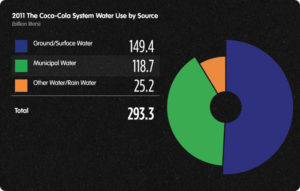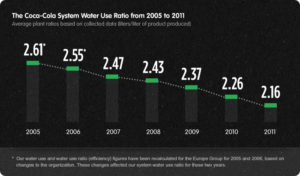Keeping Coca-Cola Hydrated: How climate change can affect water availability for the company

With climate change, water scarcity poses serious challenges to Coca-Cola’s business Model
Coca-Cola is one of the largest food / beverages company in the world, with over 125 years’ history of selling some of the most iconic brands in US Culture (Coca-Cola, Diet Coke and Coke Zero). With its operations spanning the globe (except only Cuba and North Korea), its supply chain has a large global footprint to produce 1.6 billion servings per day.[1] But this scale makes Coke more vulnerable to climate change and its consequent implications. An important one among them is water scarcity that is becoming more pronounced due to increasing temperatures.
Understanding the problem of fresh water scarcity starts with distribution of water on the planet. Approximately 98% of our water is salty and only 2% is fresh. Of that 2%, almost 70% is snow and ice, 30% is groundwater, less than 0.5% is surface water (lakes, rivers, etc) and less than 0.05% is in the atmosphere.[2] Rising temperatures interfere with the natural water cycle that may result in drastic changes in rainfall, glacier-melting, river flows and groundwater replenishment.
Coca-Cola sells value-added water, so water availability is critical for the business. However, dependence on water goes much deeper into Coke’s products. Most of the other ingredients in company’s products depend on agriculture (sugar cane, corn syrup, stevia, tea, coffee, oranges, lemons, grapes, apples, mangos, pulp and paper fiber for packaging, palm oil and soy)[3], and agriculture is the biggest consumer of fresh water supplies (70% of total water use). [4] Therefore, any disruption in water availability can have serious implications for business operations and continuity.
From the Coke’s side, most the efforts are centered around conserving water in its operations. A liter of Coke used up almost 2.6 liters of clean water in 2005 (1.5 being wasted in production process). Realizing the increasing pressure on ground-water availability (largest source of water used), Coke committed in 2005 to go water neutral by 2020.[5] This means replenishing all water used in its finished goods back to the local ecosystem and communities. They have reported to achieve this goal five years in advance, through increasing water usage efficiency in manufacturing operations and implementing projects such as protecting watersheds, raising awareness and building storage infrastructure for local communities. [6]
Coke has made great progress on plugging water wastages in its operations and setting ambitious goals for the next five years. However, it needs more focus on broader implications of water scarcity for its agricultural suppliers. It has started a Sustainable Agriculture program but that is mostly targeted at improving working conditions for the farmers and reducing forced or bonded labor. Given NASA’s report that the aquifers at the highest risk of water scarcity are support the most productive elements of world agriculture (areas such as U.S. High Plains, California’s Central Valley, China, India),[7] Coke should increase the scope of its water management efforts from manufacturing efficiency to active management of its supplier risk and collaboration.
[1] http://www.coca-colacompany.com/our-company
[2] https://www.theguardian.com/environment/2012/nov/30/climate-change-water
[3] http://www.coca-colacompany.com/stories/setting-a-new-goal-for-water-efficiency
[6] http://www.coca-colacompany.com/stories/collaborating-to-replenish-the-water-we-use
[7] http://www.nature.com/nclimate/journal/v4/n11/full/nclimate2425.html






Do you think the solution is for Coca-Cola to impose certain requirements from its suppliers and this would fix the problem?
It would be interesting to know currently what percentage of their suppliers are developing similar sustainable policies and if this is a feasible thing to do. Coca-Cola should publicly share their replenishing methodologies and strategies so the rest of the industry could apply similar policies.
On the other hand, another option Coca-Cola could do would be to vertically integrate and that way they would be responsible for taking care of this action. Would this not be part of their core business?
AR – Very interesting article. It would have been very useful to see some details on the actual actions that Coca Cola plans to take in order to go water neutral. For example, you mentioned that one of the ways they plan to do so is by raising awareness. I would be very interested to see how the company is planing to measure the effects of raising awareness on water replenishment. Is there a tangible metric that can be used to accurately measure the effects of increased awareness?
AR – thanks for this interesting article! I find Coca Cola’s initiatives of going water-neutral very interesting, especially as to my knowledge this is a (correct me if I am wrong) voluntary initiative, that is not mandated by any regulatory bodies.
In that sense, Coca Cola’s initiative reminds me of the concept of the voluntary carbon certificate market. There, companies and individuals set-off parts of their CO2 emissions by purchasing CO2 “certificates” from companies like myclimate, which in turn compensates CO2 by e.g. implementing energy-efficient technologies, planting trees etc (see their website: http://www.myclimate.org/about-us/portrait/) .
While it does generally not matter where the CO2 is set-off, it does very much do so for water, especially if e.g. Coca Cola is sourcing their water from already dry areas. Hence, I would be very interested to learn more about how Coca Cola chooses their water replenishing projects: Are they replenishing the water close to from where they are sourcing the water for their production? Are they reaching individuals that do not have enough drinking water?
A second thought that comes to mind is how Coca Cola balances their initiatives of water replenishment with their interest of controlling water sources for their own production of bottled water, like e.g. their Dasani brand. Much to the discussion about how the two Unilever brands Dove and Axe contradicted themselves in their advertising about women’s self-esteem, I am wondering on which side Coca Cola truly stands?
Wow, I was unaware of the amount of clean water that is wasted to produce 1 liter Coke in 2005! 2.6 liters to make 1 liter?! What a stat. I am curious to know what percentage of the company’s annual capital expenditures goes toward their current efforts to mitigate climate change risks (what amount of capital is dedicated to water neutral program and to their sustainable agriculture program)? Assuming the 1.6 billion servings per day quoted above, it seems to me that Coca-Cola should be investing a meaningful amount toward minimizing the potential damage from climate change – perhaps R&D to develop new innovative water efficiency technologies or alternative energy sources?